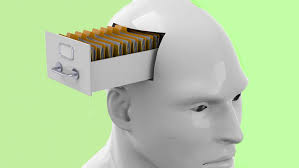 Refers to the retention and storage of information that makes learning possible.
Refers to the retention and storage of information that makes learning possible.
Refers to the brain function that allows us to encode, store and retrieve information.
Memory is the ability to preserve, retain and subsequently recall knowledge, information, or experience.
76% of persons over the age of 60 years report problems with their memory (Kovisto K et al).
Three different types of memory include: immediate or working memory, short-term memory, and long-term memory.
Requires the recording, storage, and retrieval of information
Immediate memory refers to the information retained for a short period of time without active involvement of the memory pathways.
Immediate memory can be tested and demonstrated by asking one to repeat a seven digit number.
Immediate memory can be affected by attention or language impairment or by a lesion to the superior frontal neocortex.
Short-term memory, referred to as episodic memory, implies the ability to encode, store, and retrieve information after minutes or hours.
Short-term memory requires a normal functioning of the hippocampus and post hippocampal area located in the medial temporal lobe.
Short-term memory keeps track of the tasks in which the brain is currently engaged.
Short-term memory probably consists of a group of neurons that stimulate each other in a loop to keep data in the brain’s memory.
New information replaces the old information in short-term memory within a few seconds or minutes, unless the information gets moved to long-term memory.
Long-term memory is stored in the hippocampus of the brain.
Out of the three types of memory processes, long-term memory contains the greatest amount of memory storage and is involved in most of the cognitive processes.
The amygdala regulates memory consolidation in other brain regions.
Fear conditioning, a type of memory that is impaired following amygdala damage, is mediated in part by long-term potentiation.
Emotional arousal following an event influences the strength of the subsequent memory for that event.
Greater emotional arousal following a event enhances a person’s retention of that event.
The amygdala, especially its basolateral nuclei, is involved in mediating the effects of emotional arousal on the strength of the memory for am event.
Synchronized neuronal events in the amygdala with emotional activity could promote synaptic plasticity, involved in memory retention, by increasing interactions between neocortical storage sites and temporal lobe structures involved in declarative memory.
The hippocampus transfers information from short-term memory to memory-storage regions of the brain, particularly in the cerebral cortex of the temporal lobes.
Memory related to motor skills is stored by the cerebellum and basal nuclei.
Memory, it can be deceptive at times either because the original experience was unreliable or because the memory degraded and does not accurately represent the original experience anymore.
A memory circuit include the hippocampus on each side of the brain projecting to the septal areas via the fornix, then to the mammillary bodies, and subsequently to the anterior nucleus of the thalamus, and from there it projects to the cingulate gyrus of the frontal lobe and back to the hippocampus, completing the short- term Papez memory circuit.
Short-term memory can be tested by asking about one’s activities from earlier in the day.
Long term, remote memory relates to long known information and it includes semantic memory which allows general knowledge of concepts, facts and meanings and resides in multiple cortical regions of the brain, including visual association cortex, temporal cortex and other structures involved in memory.
Microglia mediated synapse elimination underlies the act of forgetting for certain noxious stimuli, at least.
Age associated memory decline associated with an aging brain affecting cognition without clear pathologic explanation.
In humans, the process of aging particularly affects the medial temporal lobe and hippocampus, in which the episodic memory is synthesized.
The episodic memory stores information about items, objects, or features with spatiotemporal contexts.
Divided into explicit and implicit types.
Explicit memory, also known as declarative or recognition memory and it is associated with awareness or consciousness.
Explicit memory is dependent upon the hippocampus and other parts of the median temporal lobes of the brain for retention.
Declarative memory, the ability to remember recent experiences facts and events depends on the hippocampus, associated structures in the medial temporal lobe, including entorhinal, perirhinal, and parahippocampal cortexes ( Squire LR et al).
Entorhinal deep brain stimulation increases memory (Suthana K et al).
Deep brain stimulation shows electrocephalographic theta phase resetting, a electrophysiological tag for short-term learning.
Explicit memory is divided into memory of events and for words, rules and language.
Explicit memory of events is referred to as episodic memory.
Explicit memory for language, words and rules is referred to as semantic memory.
Implicit memory , also called nondeclarative, or reflexive, memory.
Implicit memory retention, in general not processed by the hippocampus and includes habits, skills, and conditioned reflexes.
Explicit memories need for various activities can become implicit once the task is thoroughly learned.
Implicit memory retention, in general not processed by the hippocampus and includes habits, skills, and conditioned reflexes.
Explicit memories need for various activities can become implicit once the task is thoroughly learned.
No effective validated treatments currently exist.
Working memory refers to temporary retention of information recently obtained or recently retreaved from long-term memory but no longer exists in the external environment.
Working memory is based on persistent neuronal activity within a network of brain regions, with the prefrontal cortex being a critical area.
Age associated decline in working memory is most likely due to loss of dendritic spines in a layer III of the cortex where recurrent excitatory networks supporting persistent neuronal activity reside.
Dendritic spines had high concentrations of cyclic AMP signaling proteins, and cyclic AMP is increased in the aged pre-frontal cortex which weakens the network connectivity of the prefrontal cortex by opening potassium channels(Wang M et al).
Memory can be improved by cognitive training (Chen AJ et al).
